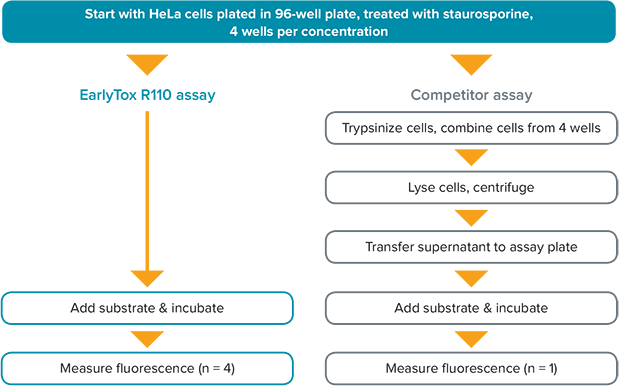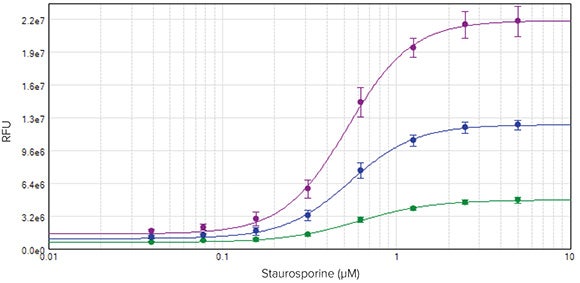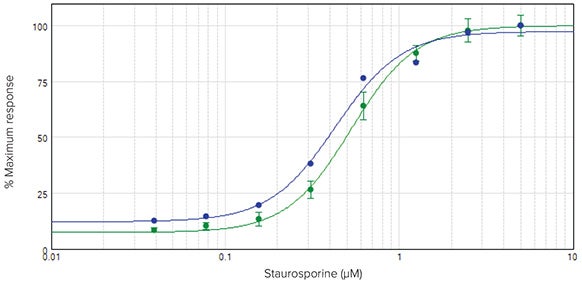
Application Note
EarlyTox Caspase-3/7 R110 Assay Kit on SpectraMax Fluorescence Microplate Readers
- Simple workflow with single reagent addition
- Increased throughput with microplate format
- Preconfigured protocol in SoftMax Pro Software
Introduction
Apoptosis is a highly regulated cellular program that causes cell death in normal processes such as embryonic development, as well as diseases including cancer and neurodegenerative conditions. Assays for apoptosis can be performed using a variety of imaging or microplate reader detection systems and provide valuable information on normal and disease-related mechanisms of cell death.
The EarlyTox™ Caspase-3/7 R110 Assay Kit provides a single-step, homogenous assay that is specifically designed for microplate readers. The fluorogenic substrate (Ac-DEVD)2-R110 contains two DEVD consensus target sequences and is completely hydrolyzed in cell lysate by the enzymes in two successive steps. Hydrolysis of both DEVD peptides releases the green fluorescent dye rhodamine 110 (R110), resulting in a substantial fluorescence increase, with excitation at 490 nm and emission at 520 nm. The simplified workflow, as described in Figure 1, reduces the number of cells required per assay and also the variability typically encountered with multiple steps.

Figure 1: EarlyTox Caspase-3/7 R110 Assay workflow.
In this application note we report the use of the EarlyTox Caspase-3/7 R110 Assay Kit in combination with SpectraMax ® fluorescence microplate readers. Fluorescent signal from the R110 dye can be detected using a SpectraMax microplate reader and rapidly analyzed using a preconfigured protocol in SoftMax® Pro Software.
Materials
- EarlyTox Caspase-3/7 R110 Assay Kit
- Explorer Kit (2-plate size): Molecular Devices P/N R8346
- Bulk Kit (10-plate size): Molecular Devices P/N R8347
- HeLa cells (ATCC P/N CCL-2)
- Staurosporine (Sigma P/N S5921)
- 96-well black, clear-bottom microplates(Corning P/N 3904)
- SpectraMax fluorescence microplate reader
Methods
HeLa cells were plated at 20,000 cells per well in 100 μL of medium in a 96-well black, clear-bottom microplate. They were allowed to attach and grow overnight in a 37°C, 5% CO2 incubator. They were then treated for 4 hours with a 1:2 dilution series of staurosporine from 5 μM down to 0.04 μM to induce apoptosis.
Substrate assay buffer was prepared by adding enzyme substrate (AC-DEVD)2-R110 (2 mM) to cell lysis/assay buffer at a ratio of 50 μL to 1 mL buffer. 100 μL of substrate assay buffer was added to each well, resulting in a final volume of 200 μL per well and a final concentration of 50 μM substrate. The samples were then incubated at room temperature for 35 minutes, 1.5 hours, or 3 hours. Fluorescence was measured on the SpectraMax i3 Multi-Mode Microplate Reader using the settings indicated in Table 1. A representative competitor assay that also uses an R110-derived caspase substrate was run for comparison (Figure 2).
Excitation = 490 nm
Emission = 520 nm
PMT Gain: Automatic
Flashes per read: 10
Read From Bottom*
Table 1. Optimized instrument settings for SpectraMax fluorescence microplate readers.

Figure 2. EarlyTox Caspase-3/7 R110 Assay Kit workflow vs. competitor assay workflow.
Results
HeLa cells treated with staurosporine for four hours exhibited an apoptotic response that was measured using the EarlyTox Caspase-3/7 R110 Assay Kit. Fluorescence corresponding to apoptotic cells was detected with the SpectraMax i3 Multi- Mode Microplate Reader. Results were graphed in SoftMax Pro Software using a 4-parameter curve fit. Cells incubated in substrate for 35 minutes, 1.5 hours, or 3 hours had similar EC50 values (Figure 3).

Figure 3: Concentration-response curves for HeLa cells treated with staurosporine for four hours. Cells were incubated in substrate for 35 minutes (•), 1.5 hours (•) or 3 hours (•). The assay plate was read on a SpectraMax i3 Multi-Mode Microplate Reader, and results were graphed in SoftMax Pro Software. The resulting EC50 values were 0.61 μM, 0.54 μM, and 0.52 μM, respectively.
Compared to a representative competitor kit, the EarlyTox R110 assay kit requires fewer steps to obtain results. The entire assay is performed directly in the microplate wells, with no need for sample transfer or other cumbersome manipulations (Figure 2). Moreover, the competitor kit requires more cells per assay sample. Here we combined cells from four wells of a 96-well plate to get each data point with the competitor assay, while we were able to obtain a separate data point from each well with the EarlyTox R110 assay. This enables multiple replicates to be run and standard deviations to be calculated (Figure 4).

Figure 4: Comparison of data for EarlyTox Caspase-3/7 R110 Assay Kit and a competitor kit. EC50 values calculated from concentration response curves were 0.61 μM for EarlyTox R110 (•) and 0.54 μM for the competitor kit (•).
Conclusion
The EarlyTox Caspase-3/7 R110 Assay Kit, used together with SpectraMax fluorescence microplate readers, gives users a simplified workflow for measuring apoptosis with the increased throughput of a microplate format. In contrast to a competitor kit, the EarlyTox R110 assay enables users to obtain separate data points from all wells of a 96-well plate without the need to pool samples from multiple wells or prepare cells in larger-well plate formats. Additionally, the EarlyTox R110 assay offers a single reagent addition step with no additional sample manipulations for faster time to results.